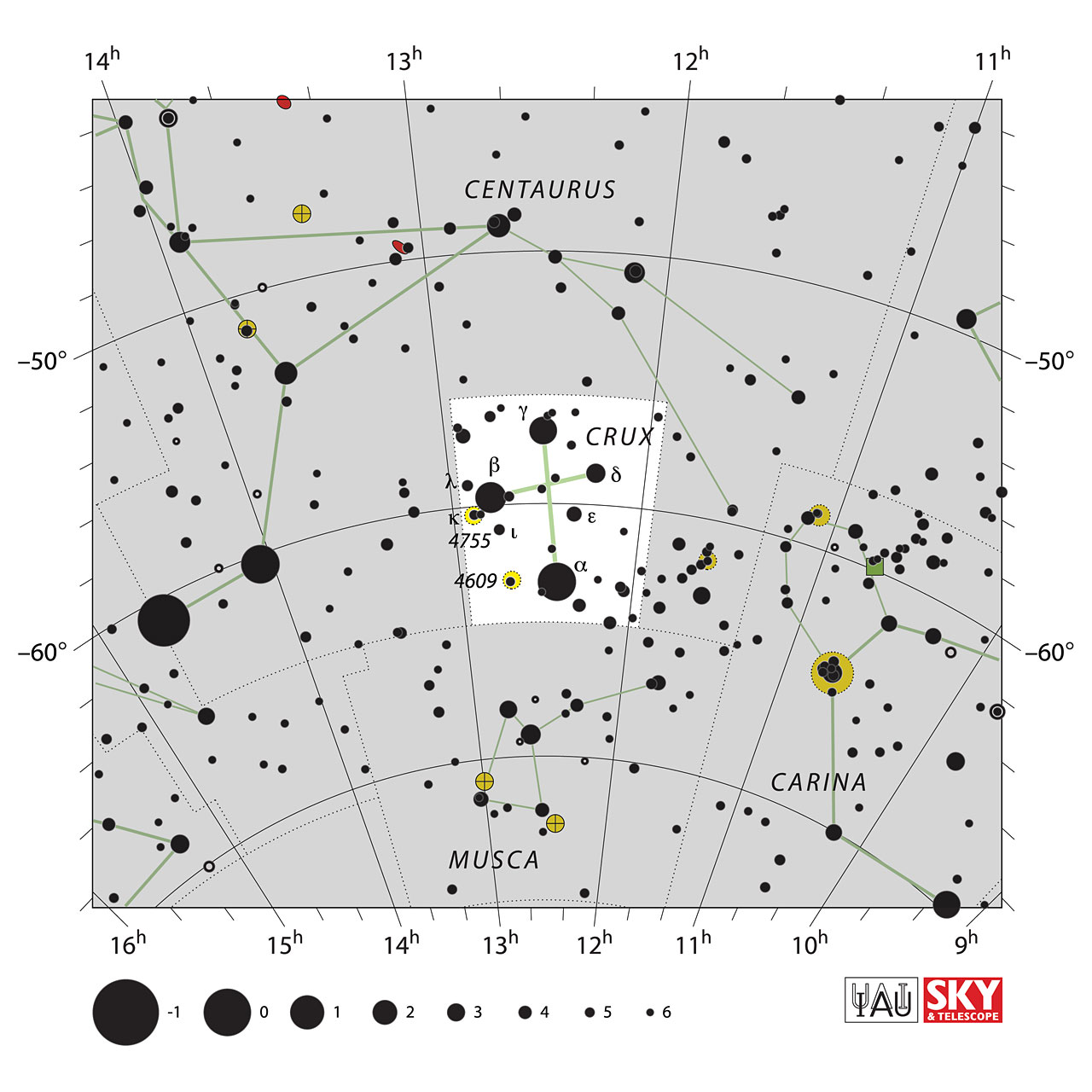Crux


Crux is the smallest of the 88 modern constellations, but also one of the most immediately recognisable. Its four brightest stars make up the Southern Cross. Crux lies in the far southern sky and is circumpolar from many southern hemisphere locations, but it appears highest in the evening sky in the months around March. It is depicted on numerous national and regional flags, including those of Australia and New Zealand.
Crux along with Alpha and Beta Centauri can be used to locate the southern celestial pole. If the vertical part of the Cross is extended and another extended line is drawn perpendicular to the line joining the 2 Centauri stars, the two extended lines meet at the Southern Celestial Pole.
Crux lies centrally within the plane of the Milky Way, and is also rich with deep sky objects, including the bright open cluster NGC 4755, commonly known as the Jewel Box.
The Coalsack Nebula, also known as C99, lies between the four stars of the southern cross, and is the most prominent of all dark nebulae. Its presence in Crux reflects the fact that this one of the most heavily dust-obscured parts of the galaxy.
The name ‘Crux’ was first used for this sky area in 1598 by Petrus Plancius and Jodocus Hondius. It was known to ancient astronomers, who considered it to be the hind legs of Centaurus.
The bright stars in Crux were known to the Ancient Greeks, where Ptolemy regarded them as part of the constellation Centaurus.
They were entirely visible as far north as Britain in the fourth millennium BC. It was possible to observe Crux from Athens up until around 400 AD. However, the precession of the equinoxes gradually lowered the stars below the European horizon, and they were eventually forgotten by the inhabitants of northern latitudes.
By 400 CE, the stars in the constellation we now call Crux never rose above the horizon throughout most of Europe. Dante may have known about the constellation in the 14th century, as he describes an asterism of four bright stars in the southern sky in his Divine Comedy.
In the Indian constellation system Crux is known as ತ್ರಿಶಂಕು (Trishanku)
Crux contains:
-
Stars
- Acrux (mag 1.3)
- Mimosa (mag 1.3)
- α²-Cru (mag 1.6)
- Gacrux (mag 1.6)
- δ-Cru (mag 2.7)
- ε-Cru (mag 3.6)
- μ¹-Cru (mag 4.0)
- ζ-Cru (mag 4.0)
- η-Cru (mag 4.1)
- θ¹-Cru (mag 4.3)
- λ-Cru (mag 4.6)
- HD 110956 (mag 4.6)
- ι-Cru (mag 4.7)
- θ²-Cru (mag 4.7)
- 256-Cru (mag 4.8)
- 39-Cru (mag 4.9)
- μ²-Cru (mag 5.0)
- BZ Cru (mag 5.3)
- HD 107696 (mag 5.4)
- HD 112244 (mag 5.4)
- HD 103961 (mag 5.4)
- BG Cru (mag 5.5)
- BL Cru (mag 5.5)
- HD 103884 (mag 5.5)
- HD 104035 (mag 5.6)
-
Open Clusters
-
Globular ClustersNone
-
GalaxyNone
View Crux in 3D 
Source: Wikipedia, in-the-sky.org
Image Courtesy: Sky&Telescope & IAU, Illustration Images linked from Urania's Mirror on Wikmedia Commons by Sidney Hall
Image Courtesy: Sky&Telescope & IAU, Illustration Images linked from Urania's Mirror on Wikmedia Commons by Sidney Hall
